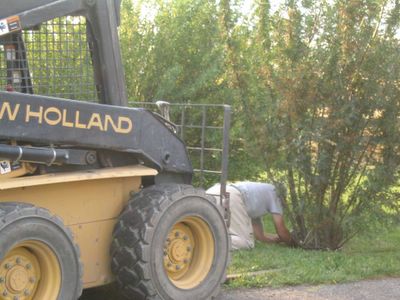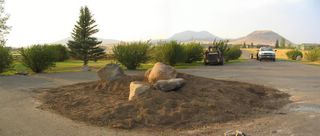This is what I did today: I was the artistic director for setting 6 large boulders in place, then the dirt-shaper and water sprayer. A bit like making mudpies ...
Here's Mike getting ready to yank out an old caragana with his loader:
Before i did much shaping ... here, the boulders had just been placed by Mike with his skid steer with the fork/loader attachment.
Some of the rocks are set
and ... just after I finished raking the (almost) final shape
I'm wetting down the new mound to compact the soil
This large flat rock forms a great bench - large enough for two people to sit and watch the sunset with their arms around each other. This is the front of the stone.
wet rocks ... i sprayed down the new soil, expecially around the boulders, to fill up any air pockets and loose soil. The lower stone is the "bench."
spraying the mound
Boulders can be used in landscaping to great effect -- or they can be plopped down any old which way and look terrible. When you are installing boulders in your garden/landscape -- remember to be sensitive to the way they are settled into the ground. Bury at least 1/3rd of the boulder so it looks like it has been there for a long time rather than just dropped from the sky randomly. If you are grouping the boulders, try to set them so they relate to each other as one rock outcropping. The angles are important - how would a large bedrock look after it becomes exposed, fractured and then weathered? Wherever possible, use stones that are available locally, so they "fit" into the natural landscape. There are lots of examples on the web of poorly-designed and executed boulder landscapes .... or you can almost as easily find examples of well-designed stone arrangements. It takes skill and artistry to import boulders into a garden with natural, pleasing results.
Monday, August 29
Subscribe to:
Post Comments (Atom)


















2 Comments:
i'm enjoying the progress!
baby steps ... slowly slowly the garden is taking shape out at my friends' place.
Post a Comment